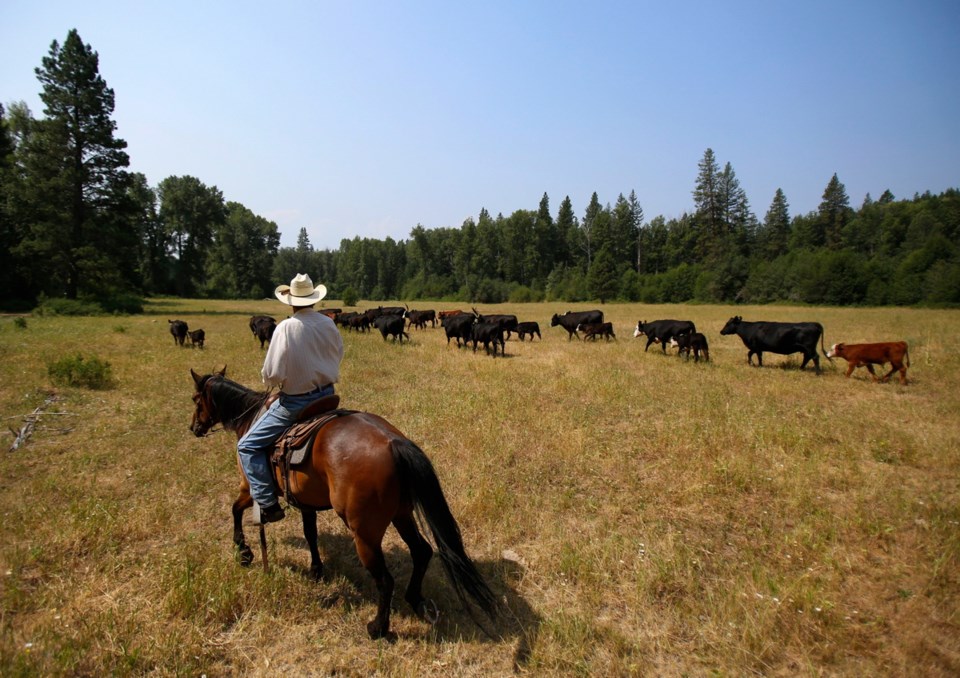Drought conditions across Vancouver Island have cattle farmers facing increased production costs, a shortage of feed and the prospect of reducing the size of their herds.
Some beef and dairy farmers are starting to wonder if they are looking at a fundamental change in how they make a living.
“It’s definitely affecting things, and one can only hope this is not the new norm,” said Colin Springford, whose Nanoose Bay Springford Farms raises beef cattle among other animals. “People have been quick to say this is the new norm, but it could just be a case that we are in for a four- or five-year drought like California.”
Grant Henry, one of the partners in Henry & Jones Grass Fed Beef, a partnership of Cowichan Valley’s Henry Farms and Ian Jones’ Wellington-based JB Farms, said regardless of whether the drought lasts a couple of years or the long-term, it will affect a farm’s bottom line and eventually the consumer.
“And if this is the norm going forward, we will all have to start looking at changing [herd] management and perhaps trying different strategies,” said Henry. “At this point, it’s hard to predict if this is the way it’s going to be.”
Environment Canada meteorologist Matt MacDonald said the dry conditions have hit the entire Island. And with a strong El Niño system expected to bring warm and dry conditions over the winter, drought could be around for a while.
MacDonald noted the south Island has had only 14.6 millimetres of precipitation between April and the end of July, compared to the norm of 94 mm.
“May was the driest May on record in Victoria since records were kept, starting in 1937,” he said, noting just two millimetres of precipitation fell that month, down from a norm of 37.5 mm.
The dry conditions have meant Island farmers have not been able to let their cattle graze on pasture or produce as much silage and hay. “There’s definitely more cost and labour involved in feeding beef cattle than watching them eat,” said Henry.
The scarcity of hay has also meant paying more for feed, and those farmers who relied on hay sales could see their revenues drop by as much as 20 to 25 per cent.
For Springford, whose hay crop has been an $80,000-a-year business, he gave up on a second cut of hay on some of his fields. That meant he had enough food for his animals, but he lost a big chunk of his bottom line through farm-gate sales to other producers.
Because of the increased cost of feed, some ranchers and farmers on the prairies have sold some of their herd to processors ahead of schedule. That doesn’t seem to have happened on the Island yet, but farmers are not ruling it out.
“I’ve been told that in some cases if there’s any reason to cull a cow, they are culling it because of the feed situation,” said Tim Mock, owner of Windhorse Farms, an organic beef farm in the Cowichan Valley. “And if this [drought] is the new norm, you will see either downsizing [herds] or shifting production.
“We recognize that with a massive El Niño coming this fall, it means worse conditions next year, so I’m afraid this might be the tip of the iceberg.”
None of the farmers interviewed said they were considering reducing their herd size this year, but Mock did note there is plenty of discussion around changing grazing patterns and, down the road, looking at reducing the carcass size of cattle.
Dairy farmers have not been spared, either.
Dave Taylor, chairman of the B.C. Dairy Association and owner of Viewfield Farm in the Comox Valley, said those with limited ability to irrigate fields have had trouble growing feed.
“There are some guys who are certainly going to be needing to supplement what they have. And the price of that is skyrocketing and that will continue, because this is not just an Island thing but a Western Canada thing,” he said. “I think we are all looking ahead and wondering if this a long-term trend, and that’s when the real concern sets in — that will really create some pressures on the whole system.”
Taylor said none of the dairy farmers he’s talked with are reducing herds at this point. “I’d say 90 per cent of us are optimistic. If not this year, then we’ll get it next year,” he said.



